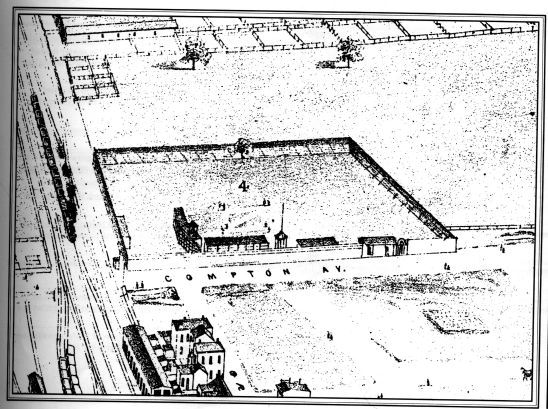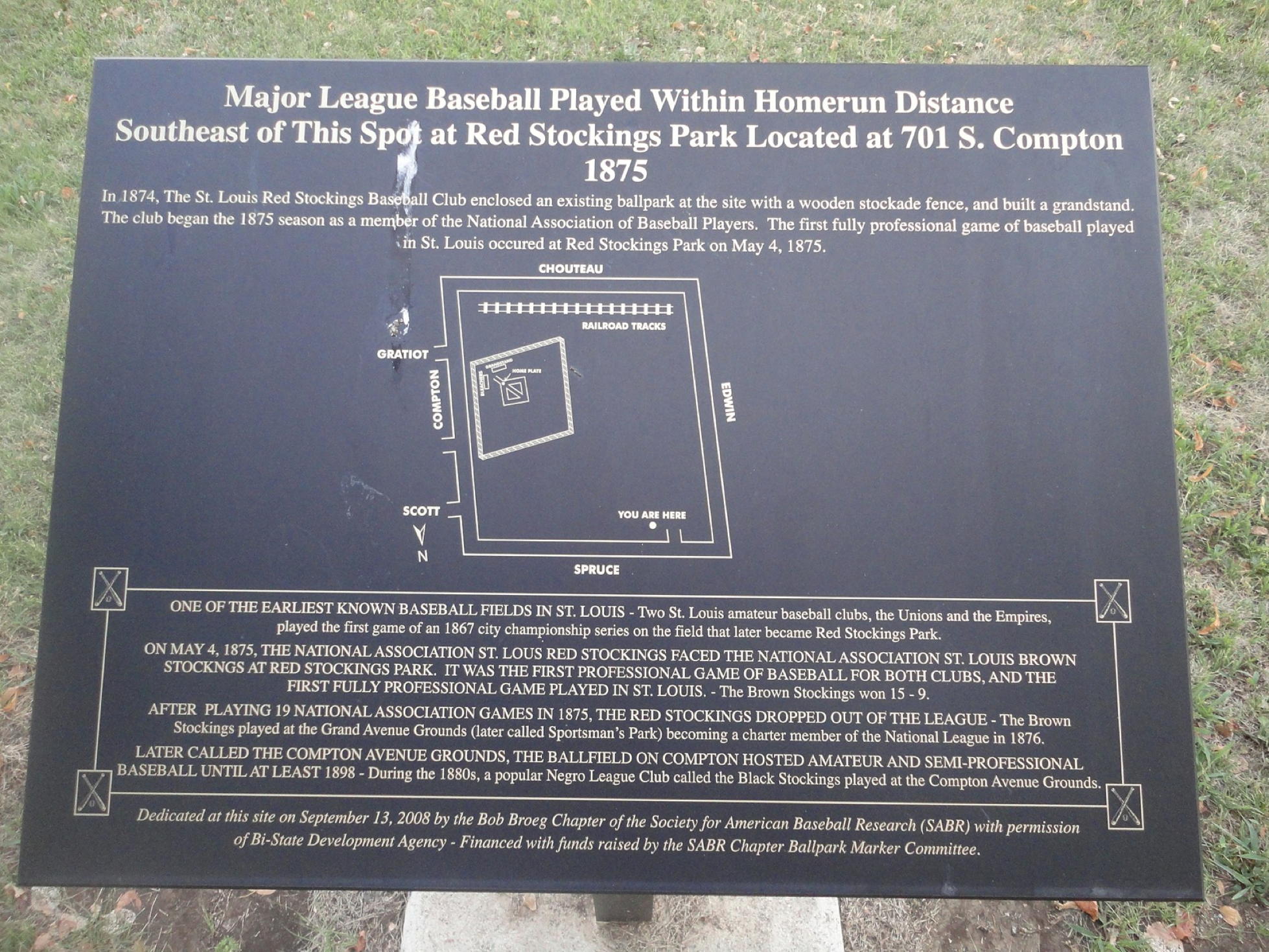Red Stockings Park
a.k.a Compton Park
 In March 1874, the club secured property near the Pacific Railroad machine shop, southwest of downtown St. Louis, at the corner of Compton and Gratiot, and built the ball field known as Red Stockings Park. The land had been used for playing baseball games at least as early as 1866, when it was described as "formerly the Empire Veto Grounds" in connection with a game between the Defiance nine and the Atlantic nine.(1) Compton avenue ran parallel to the first base line, while the train tracks ran south of the park parallel the third base line. (Game reports indicate fans would watch games from the roofs of train cars parked alongside the field.) To the west were the Pacific Stockyards. The park was a five-minute walk from the Market street cars and a ten minute walk from the Olive street cars.
In March 1874, the club secured property near the Pacific Railroad machine shop, southwest of downtown St. Louis, at the corner of Compton and Gratiot, and built the ball field known as Red Stockings Park. The land had been used for playing baseball games at least as early as 1866, when it was described as "formerly the Empire Veto Grounds" in connection with a game between the Defiance nine and the Atlantic nine.(1) Compton avenue ran parallel to the first base line, while the train tracks ran south of the park parallel the third base line. (Game reports indicate fans would watch games from the roofs of train cars parked alongside the field.) To the west were the Pacific Stockyards. The park was a five-minute walk from the Market street cars and a ten minute walk from the Olive street cars.
The grounds in question have been laid out and are enclosed by a high fence, a neat little club-house having also been erected at the main entrance.
Covered stands for the accomodaion of the fair sex have also been built, and it is the intention of those having the enterprise in hand to make the field first class in every respect.
The grounds, which have been leveled off and rolled, are in good condition for playing purposes, and the absence of grass on the infield will materially help the fielders as soon as the ground hardens a litle. The field can be reached by the Market street cars, the Chouteau avenue cars and the Blue Line.
(St. Louis Dispatch, April 27, 1874, pg. 4.)
The image of the park is from Compton and Dry's Pictorial St. Louis, published in 1875, likely drawn within a year of construction. The covered stands along the first and third base lines extend out almost to the bases on each side. The clubhouse can be seen along the first base lines between the end of the stands and the gate. A tree is present in left center field along the fence line.
Red Stockings Park, home of the St. Louis Red Stockings.
St. Louis Baseball Park, home of the St. Louis Brown Stockings.
Who built is the park not clear from the records of the time. The property was part of a large tract of land later known as the Ranken Tract, which was bounded by Manchester Road to the north and the train tracks to the south, and by Compton on the east and Ranken on the west.(2) In a dispute over the use of the property in 1880, Thomas McNeary asserted he was the sole lessee of the property and owner of the improvements upon it.(3) McNeary is not connected with the Red Stockings in the newspapers of the time until 1875, but his claim suggests he likely owned the park and club before that time. Frank McNeary, Thomas' brother, assumed control of the park in March 1881.(4)
Red Stockings Park was scheduled for its first game on April 23, 1874 against the professional Chicago White Stockings, of the National Association, who came to St. Louis for two weeks to play games against the local clubs as a tune up for their season. The game that day was played at the Grand Avenue park, as the Compton field was too wet to use. The Reds lost by a score of 6-0. An error by Redmond in the sixth led to four of the runs. The next game of the series was played on April 27 at Red Stockings Park; it was called after two innings because of rain, with the White Stockings leading 4-1. Finally, after the two aborted attempts, the first complete game at Red Stockings Park was played on April 30 against the White Stockings. The Reds lost 31-10.
The park was the home of the Red Stockings during their stint in the National Association, and it was the site of the first fully professional game in St. Louis, on May 4, 1875, when the Brown Stockings defeated the Red Stockings by a score of 15-9. A week later, it was the site of the first game ever won by a score of 1-0 (per national reports at the time), with the Red Stockings on the losing end against Chicago.
The Red Stockings played at the park from 1874 through their disolution in March 1877. Various incarnations of the club continued to play there into the 1880s. It was also used by other clubs over the years. The nationally known African-American St. Louis Black Stockings played games at the park in the 1880s. One game of theirs in June 1883 reportedly drew 4000 fans to the park.(5) In the 1880s, the St. Louis Gun Club used the property as well for tournaments and practice.
The site was one of the locations considered for building a park for the Federal League Terriers in the winter of 1914.(6)
 The park was known as Red Stockings Park until 1885, when it was renamed Compton Park. It was torn down in 1898. The site is now a Bi-State (Metro) repair facility, just west of the Compton Avenue viaduct and south of Spruce.
The park was known as Red Stockings Park until 1885, when it was renamed Compton Park. It was torn down in 1898. The site is now a Bi-State (Metro) repair facility, just west of the Compton Avenue viaduct and south of Spruce.
A site just north of Red Stockings Park, at Compton and North Market, was later used by several Negro League clubs during the 1920's and 1930's, including the 1928 NNL Champion St. Louis Stars. The park there was known as Stars Park. That site is now owned by Harris-Stowe college.
References
(1) "Base Ball," Missouri Democrat, May 10, 1866, pg. 4.
(2) "Ranken First to Endow His School," St. Louis Globe-Democrat, December 1, 1907, pg. 1. Ranken Street no longer exists to the west of Compton in this area but is still there south of Chouteau. David Ranken, Jr. owned half interest in the property, and Thomas Ranken, Jr. owned the other half. David leased the land to the Terminal Railroad Association in 1907 to raise money for the founding of Ranken Technical College.
(3) "Thomas McNeary," St. Louis Post-Dispatch, May 18, 1880, pg. 5.
(4) "Base Ball. The Outlook at Home," St. Louis Globe-Democrat, May 27, 1881, pg. 11.
(5) "Won by One Run," St. Louis Globe-Democrat, June 4, 1883, pg. 5.
(6) "Park Problem Bothers St. Louis Club," St. Louis Globe-Democrat, December 31, 1913, pg. 10.
 In March 1874, the club secured property near the Pacific Railroad machine shop, southwest of downtown St. Louis, at the corner of Compton and Gratiot, and built the ball field known as Red Stockings Park. The land had been used for playing baseball games at least as early as 1866, when it was described as "formerly the Empire Veto Grounds" in connection with a game between the Defiance nine and the Atlantic nine.(1) Compton avenue ran parallel to the first base line, while the train tracks ran south of the park parallel the third base line. (Game reports indicate fans would watch games from the roofs of train cars parked alongside the field.) To the west were the Pacific Stockyards. The park was a five-minute walk from the Market street cars and a ten minute walk from the Olive street cars.
In March 1874, the club secured property near the Pacific Railroad machine shop, southwest of downtown St. Louis, at the corner of Compton and Gratiot, and built the ball field known as Red Stockings Park. The land had been used for playing baseball games at least as early as 1866, when it was described as "formerly the Empire Veto Grounds" in connection with a game between the Defiance nine and the Atlantic nine.(1) Compton avenue ran parallel to the first base line, while the train tracks ran south of the park parallel the third base line. (Game reports indicate fans would watch games from the roofs of train cars parked alongside the field.) To the west were the Pacific Stockyards. The park was a five-minute walk from the Market street cars and a ten minute walk from the Olive street cars.